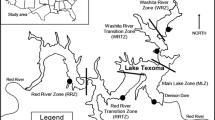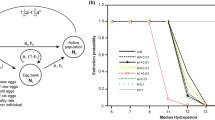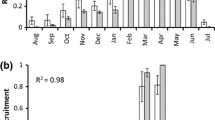Abstract
Zebra mussels (Dreissena polymorpha, Pallas, 1771) have had unprecedented success in colonizing European and North American waters under strongly differing temperature regimes. Thus, the mussel is an excellent model of a species which is able to cope with increasing water temperatures expected under global change. We study three principle scenarios for successful survival of the mussel under rising temperatures: (1) no adaptation to future thermal conditions is needed, existing performance is great enough; (2) a shift (adaptation) towards higher temperatures is required; or (3) a broadening of the range of tolerated temperatures (adaptation) is needed. We developed a stochastic individual-based model which describes the demographic growth of D. polymorpha to determine which of the alternative scenarios might enable future survival. It is a day-degree model which is determined by ambient water temperature. Daily temperatures are generated based on long-term data of the River Rhine. Predictions under temperature conditions as recently observed for this river that are made for the phenology of reproduction, the age distribution and the shell length distribution conform with field observations. Our simulations show that temporal patterns in the life cycle of the mussel will be altered under rising temperatures. In all scenarios spawning started earlier in the year and the total reproductive output of a population was dominated by the events later in the spawning period. For maximum temperatures between 20 and 26°C no thermal adaptation of the mussel is required. No extinctions and stable age distributions over generations were observed in scenario 2 for all maximum temperatures studied. In contrast, no population with a fixed range of tolerated temperatures survived in scenario 3 with high maximum temperatures (28, 30, 32°C). Age distributions showed an excess of 0+ individuals which resulted in an extinction of the population for several thermal ranges investigated.






Similar content being viewed by others
References
Bastviken DTE, Caraco NF, Cole JJ (1998) Experimental measurements of zebra mussel (Dreissena polymorpha) impacts on phytoplankton community composition. Freshwater Biol 39:375–386
Borcherding J (1991) The annual reproductive cycle of the freshwater mussel Dreissena polymorpha Pallas in lakes. Oecologia 87:208–218
Borcherding J (1992) Morphometric changes in relation to the annual reproductive cycle in Dreissena polymorpha—a prerequisite for biomonitoring studies with zebra mussels. In: Neumann D, Jenner HA (eds) The zebra mussel Dreissena polymorpha: ecology, biological monitoring and first applications in water quality management. Limnologie aktuell 4. Fischer, Stuttgart, pp 87–99
Borcherding J, Sturm W (2002) The seasonal succession of macroinvertebrates, in particular the zebra mussel (Dreissena polymorpha), in the River Rhine and two neighbouring gravel-pit lakes monitored using artificial substrates. Int Rev Hydrobiol 87:165–181
Borcherding J, de Ruyter van Steveninck ED (1992) Abundance and growth of Dreissena polymorpha larvae in the water column of the River Rhine during downstream transportation. In: Neumann D, Jenner HA (eds) The zebra mussel Dreissena polymorpha: ecology, biological monitoring and first applications in water quality management. Limnologie aktuell 4. Fischer, Stuttgart, pp 29–44
Both C, Visser ME (2001) Adjustment to climate change is constrained by arrival date in a long-distance migrant bird. Nature 411:296–298
Edwards M, Beaugrand G, Reid PC, Rowden AA, Jones MB (2002) Ocean climate anomalies and the ecology of the North Sea. Mar Ecol Prog Ser 239:1–10
DeAngelis DL, Gross LJ (1992) Individual-based models and approaches in ecology: populations, communities and ecosystems. Chapman Hall, New York
DeAngelis DL, Mooij WM (2005) Individual-based modeling of ecological and evolutionary processes. Annu Rev Ecol Evol Syst 36:147–168
Einsle U (1973) Zur Horizontal- und Vertikalverteilung der Larven von Dreissena polymorpha im Pelagial des Bodensee-Obersees (1971). Gas-Wasserfach Wasser Abwasser 114:27–30
Elliott JM, Hurley MA, Maberly SC (2000) The emergence of sea trout fry in a Lake District stream correlates with the North Atlantic Oscillation. J Fish Biol 56:208–210
Garton DW, Johnson LE (2000) Variation in growth rates of the zebra mussel, Dreissena polymorpha, within Lake Wawasee. Freshwater Biol 45:443–451
Grabherr G (1994) Climate effects on mountain plants. Nature 369:448
Griebeler EM, Gottschalk E (2000) The influence of temperature model assumptions on prognosis accuracy of extinction risk. Ecol Modell 134:343–356
Grimm V, Railsback SF (2005) Individual-based modeling and ecology. Princeton University Press, Princeton, N.J.
Hebert PDN, Muncaster BW, Mackie GL (1989) Ecological and genetic studies in Dreissena polymorpha (Pallas): a new mollusc in the Great Lakes. Can J Fish Aquat Sci 46:1587–1591
Hill JK, Thomas CD, Huntley B (1999) Climate change and habitat availability determine 20th century changes in a butterfly’s range margin. Proc R Soc Lond B 266:1197–1206
Houlahan JE, Findlay CS, Schmidt BR, Meyer AH, Kuzmin SL (2000) Quantitative evidence for global amphibian population declines. Nature 404:752–755
IPCC (International Panel on Climate Change) (2001) Climate change 2001: impacts, adaptations and vulnerability. UNEP, WHO
Jantz B (1996) Wachstum, Reproduktion, Populationsentwicklung und Beeinträchtigung der Zebramuschel (Dreissena polymorpha) in einem großen Fließgewässer, dem Rhein. Dissertation, University of Cologne
Jantz B, Neumann D (1992) Shell growth and population dynamics of Dreissena polymorpha in the river Rhine. In: Neumann D, Jenner HA (eds) The zebra mussel Dreissena polymorpha: ecology, biological monitoring and first applications in water quality management. Limnologie aktuell 4. Fischer, Stuttgart, pp 49–66
Jantz B, Neumann D (1998) Growth and reproductive cycle of the zebra mussel in the River Rhine as studied in a river bypass. Oecologia 114:213–225
Jenner HA, Jansen-Mommen JPM (1993) Monitoring and control of Dreissena polymorpha and other macrofouling bivalves in the Netherlands. In: Nalepa TF, Schloesser DW (eds) Zebra mussels—biology, impacts, and control. Lewis, Boca Raton, Fla., pp 537–554
Keller F, Kienast F, Beniston M (2000) Evidence of response of vegetation to environmental change on high-elevation sites in the Swiss Alps. Reg Environ Change 1:70–77
Kemp WP, Onsager JA (1986) Rangeland grasshoppers (Orthoptera: Acrididae): modelling phenology of natural populations of six species. Environ Entomol 15:924–930
Lauer TE, Spacie A (2004) Space as a limiting resource in freshwater systems: competition between zebra mussels (Dreissena polymorpha) and freshwater sponges (Porifera). Hydrobiologia 517:137–145
Lewandowski K, Ejsmont-Karabin J (1983) Ecology of planktonic larvae of Dreissena polymorpha (Pallas) in lakes with different degree of heating. Pol Arch Hydrobiol 30:89–101
Liakhnovich VN, Karataev AY et al. (1994) Habitat parameters. In: Starobogatov YI (eds) Freshwater zebra mussel Dreissena polymorpha (Pall.) (Bivalvia, Dreissenidae) taxonomy, ecology and practical use. Nauka, Moscow, pp 67–109
Marco DE, Páez SA (2000) Invasion of Gleditsia triacanthos in Lithraea ternifolia montane forests of central Argentina. Environ Manage 26:409–419
Marsden JE, Spiedle AP, May B (1996) Review of genetic studies of Dreissena spp. Am Zool 36:259–270
McMahon RF (1996) The physiological ecology of the zebra mussel, Dreissena polymorpha, in North America and Europe. Am Zool 36:339–363
Meisenheimer J (1901) Entwicklungsgeschichte von Dreissena polymorpha Pall. Z Wiss Zool 69:1–137
Mehlig B, Pohlmann M et al. (2004) Das hydrologische Jahr 2003 und das außergewöhnliche Niedrigwasser im Sommer 2003. Jahresbericht 2003. Landesumweltamt NRW, pp 47–62
Minchin D, Lucy F, Sullivan M (2002) Zebra mussels: impact and spread. In: Leppäkoski E, Gollasch S, Olenin S (eds) Invasive aquatic species of Europe—distribution, impact and management, Kluwer, Dordrecht, pp 135–146
Möllmann C, Kornilovs G, Sidrevics L (2000) Long-term dynamics of main mesozooplankton species in the central Baltic Sea. J Plankton Res 22:2015–2038
Müller J, Wöll S, Fuchs U, Seitz A (2001) Genetic interchange of Dreissena polymorpha populations across a canal. Heredity 86:103–109
Nalepa TF, Schloesser DW (1993) Zebra mussels—biology, impacts, and control. Lewis, Boca Raton, Fla.
Neumann D (1990) Macrozoobenthos-Arten als Bioindikatoren im Rhein und seinen angrenzenden Baggerseen. In: Kinzelbach R, Friedrich G (eds) Biologie des Rheins. Fischer, Stuttgart, pp 87–105
Neumann D, Borcherding J, Jantz B (1993) Growth and seasonal reproduction of Dreissena polymorpha in the Rhine River and adjacent waters. In: Nalepa TF, Schloesser DW (eds) Zebra mussels—biology, impacts, and control. Lewis, Boca Raton, Fla., pp 95–109
North AW (2005) Mackerel icefish size and age differences and long-term change at South Georgia and Shag Rocks. J Fish Biol 67:1666–1685
Orlova MI (2002) Dreissena (D.) polymorpha: evolutionary origin and biological peculiarities as prerequisites of invasion process. In: Leppäkoski E, Gollasch S, Olenin S (eds) Invasive aquatic species of Europe—distribution, impact and management, Kluwer, Dordrecht, pp 127–134
Parmesan C, Ryrholm N et al (1999) Poleward shifts in geographical ranges of butterfly species associated with global warming. Nature 399:579–583
Peterson AT, Ortega-Huerta MA, Bartley J, Sánchez-Cordero V, Soberón J, Buddemeier RH, Stockwell DRB (2002) Future projections for Mexican faunas under global climate change scenarios. Nature 416:626–629
Pöckel M, Webb BW, Sutcliffe DW (2003) Life history and reproductive capacity of Gammarus fossarum and G. roeseli (Crustacea: Amphipoda) under naturally fluctuating water temperatures: a simulation study. Freshwater Biol 48:53–66
Pounds JA, Fogden MPL, Campbell JH (1999) Biological response to climate change on a tropical mountain. Nature 398:611–615
Railsback SF (2001) Concepts from complex adaptive systems as a framework for individual-based modelling. Ecol Modell 139:47–62
Ramcharan CW, Padilla DK, Dodson SI (1997) Models to predict potential occurrence and density of the zebra mussel, Dreissena polymorpha. Can J Fish Aquat Sci 49:2611–2620
Ruyter van Steveninck ED de, Admiraal W, Zanten B van (1990) Changes in plankton communities exposed to sedimentation in regulated reaches of the lower River Rhine. Regul Rivers 5:67–75
Roy DB, Sparks TH (2000) Phenology of British butterflies and Climate change. Global Change Biol 6:407–416
Sanz JJ (2002) Climate change and breeding parameters of great and blue tits throughout the western Palearctic. Global Change Biol 8:409–422
Sanz JJ (2003) Large-scale effects of climate change on breeding parameters of pied flycatchers in Western Europe. Ecography 26:45–50
Schmidt-Nielsen K (1997) Animal physiology. Adaptation and environment. Cambridge University Press, Cambridge
Schneider DW (1992) A bioenergetics model of zebra mussel, Dreissena polymorpha growth in the Great Lakes. Can J Fish Aquat Sci 49:1406–1416
Smit H, Bij de Vaate A, Fioole A (1992) Shell growth of the zebra mussel (Dreissena polymorpha, Pallas) in relation to selected physico-chemical parameters in the Lower Rhine and some associated lakes. Arch Hydrobiol 124:257–280
Smit H, Bij de Vaate A, Reeders HH, Nes EH van, Noordhuis R (1993) Colonisation, ecology, and positive aspects of zebra mussels (Dreissena polymorpha) in The Netherlands. In: Nalepa TF, Schloesser DW (eds) Zebra mussels—biology, impacts, and control. Lewis, Boca Raton, Fla., pp 55–77
Sparks TH, Carey PD (1995) The response of species to climate over the centuries: an analysis of the Marsham phenology record 1736–1947. J Ecol 83:321–329
Sparks TH, Yates TJ (1997) The effect of spring temperatures on the appearance dates of butterflies 1883–1993. Ecography 20:368–374
Sprung M (1987) Ecological requirements of developing Dreissena polymorpha eggs. Arch Hydrobiol Suppl 79:69–86
Sprung M (1991) Costs of reproduction: a study on metabolic requirements of the gonads and fecundity of the Bivalve Dreissena polymorpha. Malacologia 33:63–70
Sprung M (1993) The other life: an account of present knowledge of the larval phase of Dreissena polymorpha. In: Nalepa TF, Schloesser DW (eds) Zebra mussels—biology, impacts, and control. Lewis, Boca Raton, Fla., pp 39–54
Straile D (2000) Meterological forcing of plankton dynamics in a large and deep continental European lake. Oecologia 122:44–50
Thomas CD, Lennon JJ (1999) Birds extend their ranges northwards. Nature 399:213
Wake DB (1991) Declining amphibian populations. Science 253:860
Wand SJE, Midgley GF, Jones MH, Curtis PS (1999) Response of wild C4 and C3 grass (Poacea) species to elevated atmospheric CO2 concentration: a meta-analytic test of current theories and perceptions. Global Change Biol 5:723–741
White TA, Campbell BD, Kemp PD, Hunt CL (2000) Sensitivity of three grassland communities to simulated extreme temperature and rainfall events. Global Change Biol 6:671–684
Acknowledgements
We thank the Bundesanstalt für Gewässerkunde for granting access to water temperature data of the River Rhine. We are grateful to Otto Richter, Dagmar Söndgerath and Claudia Bruhn (Technical University of Braunschweig, Germany) for supporting the analysis of long-term water temperatures as well as to Jes Johannesen, Nina Farwig and three anonymous reviewers for their valuable comments on this manuscript. This research was granted by the Deutsche Forschungsgemeinschaft (Se 506/13-1).
Author information
Authors and Affiliations
Corresponding author
Additional information
Communicated by Ulrich Sommer.
Priority programme of the German Research Foundation—contribution 14.
Rights and permissions
About this article
Cite this article
Griebeler, E.M., Seitz, A. Effects of increasing temperatures on population dynamics of the zebra mussel Dreissena polymorpha: implications from an individual-based model. Oecologia 151, 530–543 (2007). https://doi.org/10.1007/s00442-006-0591-0
Received:
Accepted:
Published:
Issue Date:
DOI: https://doi.org/10.1007/s00442-006-0591-0




